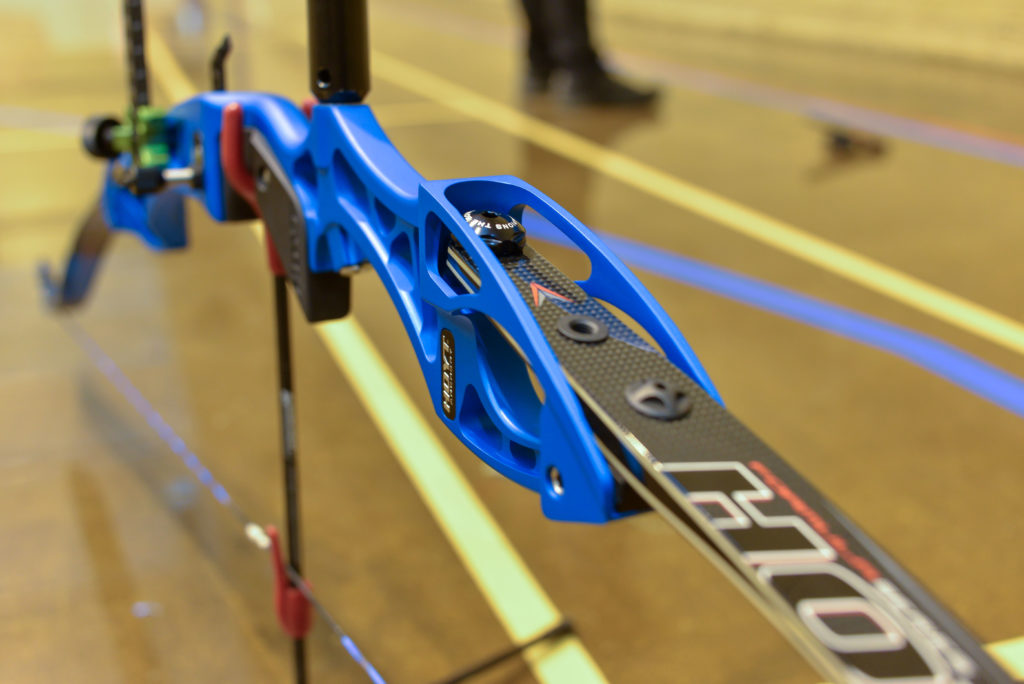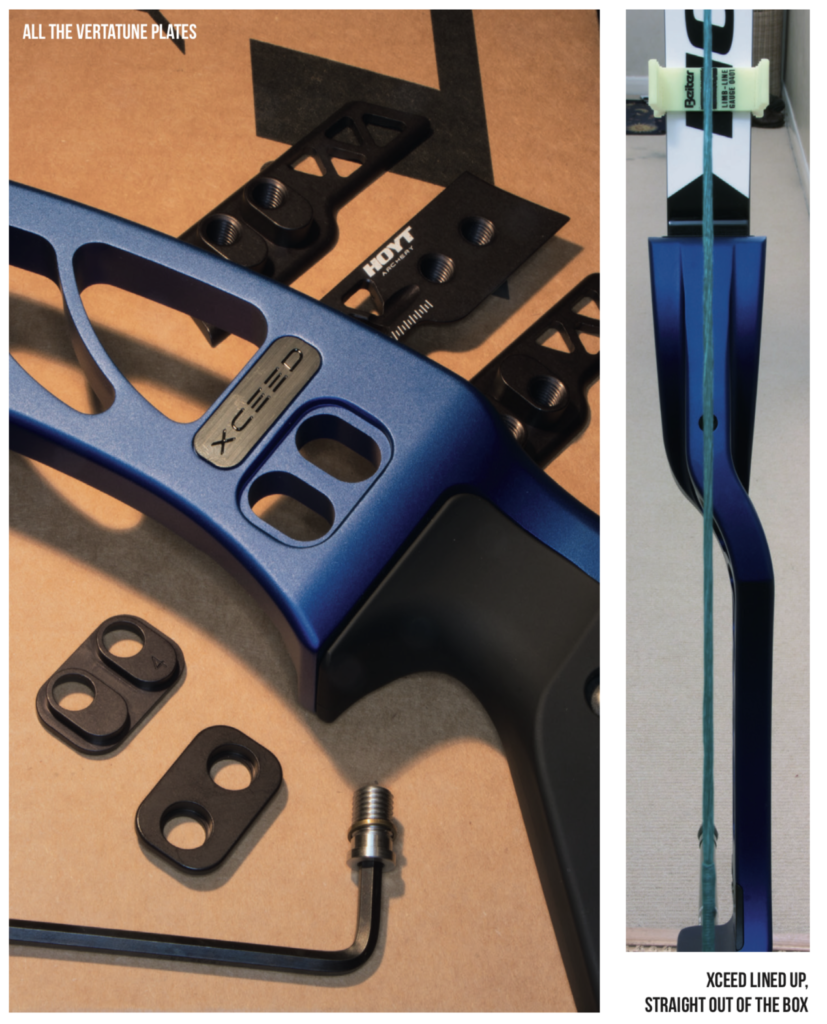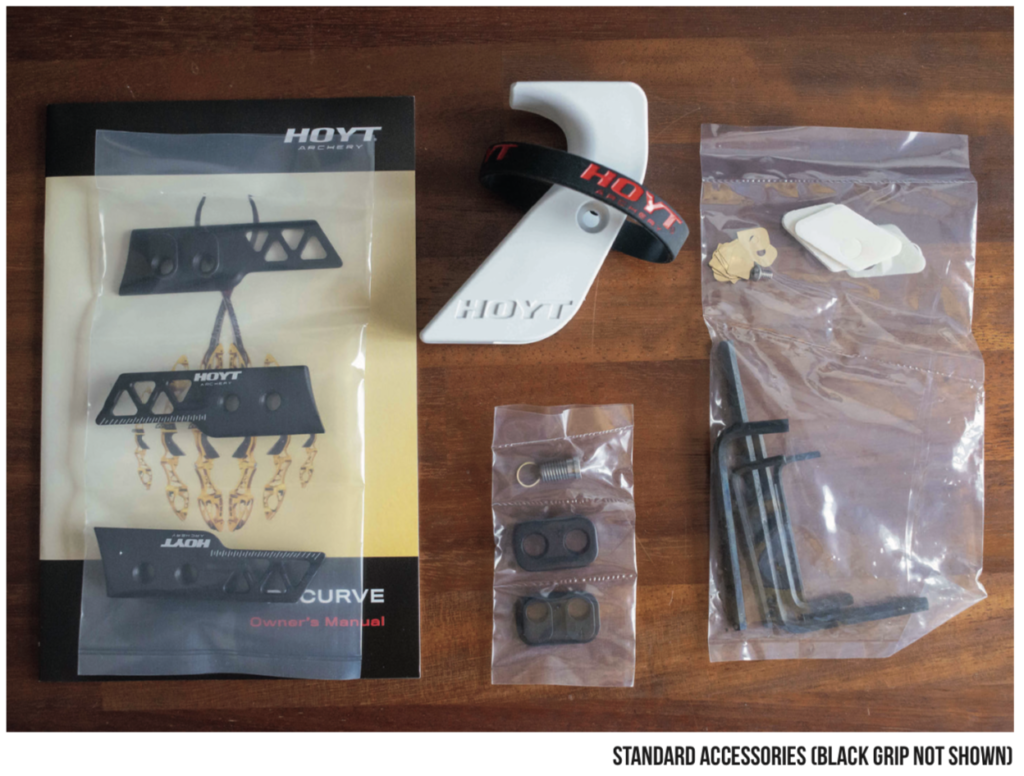With some brand new technology on offer, how do the latest top-line Hoyt recurve offerings work out? By Mark Brown and John Stanley

The new-for-2020 Hoyt Xceed Grand Prix riser sees a continuation of the new features introduced to Hoyt’s range last year, together with a corrective update or two, and an interesting new adjustment: String Tension Technology (STT), which I shall explore in depth shortly.
Out of the box, the first thing you notice is, of course, the aesthetics. This is obviously a personal thing, but I try as I might, I have found it difficult to love the look of some of Hoyt’s recent offerings: bulky, heavy, form not really following function.
This bow looks so much better: simpler and lighter, with any complexity hidden away. The riser comes with two identically shaped grips, one black, one white, which enable you to pick your favourite look – or indeed allows you to reshape one grip to suit your hand, and keep the other stock.

The white grip looks great, though I’m not sure how long it will stay white. It comes with no fewer than three VertaTune plates in high, middle, and low – and it is available in nine colours, all satin finish, which, while looking good, does make me worry about how well it will take scratches.
Setting the bow up for a basic tune is a doddle. The limb bolts are redesigned for 2020; the shape has changed from “expanding” as the lock nut is tightened, to “flat-to-flat” with the lock nuts.
As one chap shooting next to me was keen to point out, on his Hoyt Epik, the previous design came loose far too easily, allowing the bow to slip out of tune unnoticed (at best – spectacularly at worst).
The new limb bolts feel absolutely solid, with no sign of slippage over the three weeks I shot and adjusted them. I was using a pair of new Hoyt Grand Prix Carbon Integra limbs. These were superb: the fit was perfect, and I mean absolutely spot-on. This matters enormously: it makes the bow quieter, and better able to hold a tune reliably, from set-up to competition.
There is a lot to be said for sticking to one manufacturer, even for an ILF riser like the Xceed. Rather unfortunately, from the point of view of a reviewer, the limbs were perfectly aligned so I was unable to try the variety of adjustment on offer. (Although I grabbed the hex keys and set about gratuitously adjusting it from good to bad, and then back again to make sure).
Hoyt have stuck with the change introduced last year away from using shims to adjust the left-right position of the limbs in the pockets. The problem with shims is that you have to unstring the bow; it’s fiddly (don’t drop the shim!) and often you can’t ever get it perfect, only being able to adjust in increments of one washer. The Xceed has the side-to-side screws introduced so belatedly to allow perfect adjustment with no need to unstring.
Easy job, but perhaps slightly concerning that there are no lock nuts. They showed no signs of slipping while I had the bow. Limb-tip alignment (where the limb tips of a strung bow point away from the centre line, despite the limbs themselves being in good alignment with the riser) can be adjusted by adding some of the ten or so thin brass shims included, screwed down on either side of the limb pocket.
This makes ‘official’ an adjustment that many archers carried out for themselves, packing out one side of the limb pocket to turn the limb slightly until the tips are true. To be honest, if your limbs are that wonky, you should be sending them back, not packing them out.
I was new to Hoyt’s VertaTune system, which gives you three options for the height of the button and arrow rest. Swapping the units over is extremely easy, provided you have three arrow rests ready, one for each plate – and remember to adjust the nock point on your string.


Provided you keep the nock point the same distance above the arrow rest, you don’t really need to re-tune for a basic set-up. I quickly settled on the highest option (also popular with Brady Ellison -Ed). The difference in grouping was amazing, one of those “getting away with murder” settings. Oh joy!
There are the usual bushings for weights: front and back below the grip, and top and bottom limb pockets. Available separately from Hoyt are small weights, which can be screwed directly to the inside of the limb pockets, and a choice of larger weights for barebowers, which clamp directly to the riser below the grip, settling into a specially machined but easy-to-ignore recess.
So, what of this String Tension Technology? There are two small rockers in both limb pockets, two at each side, where the back of the limb rests. It’s the last part of the limb to be in contact with the riser. Essentially, the Xceed allows you to adjust these rockers in and out, towards or away from the grip, effectively making the limb a few millimetres longer or shorter.
The theory is that the setting furthest from the grip, the ‘performance’ setting, gives you a slight ramping up of bow weight as you come though the clicker; the setting closest to the grip (‘smooth’) gives a much gentler feel through the expansion: less stacking; the middle setting (‘hybrid’) is a compromise between the two.
Which setting you prefer is of course personal, but I will say that I first tried the performance setting, and it felt incredibly smooth, as if I could keep drawing that bow on and on forever. I then tried the smooth setting, and it felt the same. So I did what any self-respecting nerd would do (and very few reviews do any more): I plotted a draw force curve for both settings.
The shape of both curves ran together, parallel if you will, with about three quarters of a pound difference consistently between the two. This goes with what I felt when drawing the bow: no difference throughout the shot, but with a small unnoticed change in poundage – without adjusting the limb bolts, which can subtly alter the geometry of the limbs.
I measured the distance between the limb bolt and the rocker in each setting; they are 56, 62, and 67mm from smooth to performance. I then measured my own Win & Win aluminium riser; it was a much bigger 74mm. Given this is what I’m used to, that may explain why the Xceed feels so smooth even on the performance setting.
Interestingly, my old Hoyt Nexus riser also measured 67mm on its one and only setting. Essentially, we are being offered a variable deflex, which will slightly change the way the limbs load and slightly change the poundage – and the tune, at least a little. You may be able to get more out of it than me.
Hoyt’s now standard high-ish grip wasn’t my favourite, but one size cannot fit all, and what we have here is a good starting point for personalising it. As third party manufacturers make grips for all the top selling bows, you have no excuse.
Enough fiddling already – let’s shoot it. The riser feels deceptively light, perhaps because it looks like it ought to be heavier, or perhaps because of the recesses in the limb pockets, where a lot of weight has been removed.
At 1270 grams it is actually lighter than most, but the way the weight is distributed makes it feel so much lighter, so easy to keep on the gold, but with enough real mass to absorb the shock and hold things steady in the wind.
This makes for a for a gloriously quiet and gentle shot, even with a brace height randomly set somewhere in the middle of the recommended range.
The whole package, with the intermediate Integra limbs, feels almost like it’s a one-piece bow with no join – it really is that smooth. Is it worth the £750+ price tag?
If money was no object, and after shooting back-to-back with a top-of-the-range Win & Win aluminium riser, there is no contest – I’d choose the Hoyt with wood core limbs. It’s a total joy to shoot: smooth, cooperative, forgiving. Can I keep it, please? Please?
Hoyt Formula Xi
Hoyt does not always update their top-of-the-line Formula riser at the same time as the ILF range, but this time the Formula X riser had been tweaked too, to add the same features as the Xceed.
The Xi is produced in the same way as the Xceed and – as you would hope at this price point – is beautifully finished. I really enjoyed the narrowish high composite grip currently supplied with the premium recurve lines, particularly the material and the feel on the skin, but grips are very personal and if you are in the market for a riser like this, hopefully you already know what you might need.
JVD had been kind enough to supply us with a set of 28lb Velos limbs, which were exceptionally smooth and clean. I tested that setup with aluminiums indoors and it felt like a bow several pounds lighter. The Velos limbs have been a hit around the world with elite archers, and Hoyt will have to go some way to topping them.

I then fired up the Xi with two pairs of Formula limbs: 36lb Hoyt X-Factor limbs in medium and 38lb MK Archery Mach-X limbs in long, and got a basic tune together quickly, to test the fabled string tension technology. I didn’t have time to conduct a full test with the middle ‘hybrid’ setting, so I settled for switching back and forth a few times between the extremes of the ‘performance’ and ‘smoothness’ settings. It is subtle, but I’m pretty sure I noticed a small difference at the clicker point on the ‘smoothness’ settings. Execution seemed just a fraction less aggressive. The difference was more noticeable on the medium Hoyt limbs. Having said that, this is a small and subtle change, difficult to quantify and clearly depends on the limbs you may be using. I think that expert archers who really like to experiment with different limb combinations might really get some use out of it, as a tuning tweak. For more casual shooters like myself, anything that improves smoothness, even a little, is just fine by me.
The technology may have grabbed the headlines, but apart from that, this really is an exceptionally nicely balanced riser, easy to setup, easy to adjust, and a marked improvement in response from my 2016 X-Factor Formula riser – and I enjoy its aesthetic curves a little more too. The VertaTune plate system allows you to swap indoor to outdoor more easily than anything I have seen so far. Enter our competition on page 58 to win it!


Nice review. Thanks.
You have made my mind up for me.
Am hoping to upgrade to an X/Xi riser this year at some point.
Not too bothered about the STT so will be trying to get an X.
Very, Very well written and to the point ! A complete pleasure to read and comprehend. A+ for sure. Does make me want to try the Exceed Riser. Great that there are honest reviewers for the many new adaptations that abound in the archery-tech world. Does make one wonder if there is a perfect riser design that you can’t go beyond ( physics being what it is ) Like the old 10 meter yacht intrepid which within the 10 meter formula (with out adding weird keels and foils was a little like natures shark evolution unchanged for millions of years. So to keep selling new equipment bow designers go “round and round”. So without adding gyro’s and laser levelers how far can we go ? Great Job and THANKS, Greg Mort Ashton Maryland USA